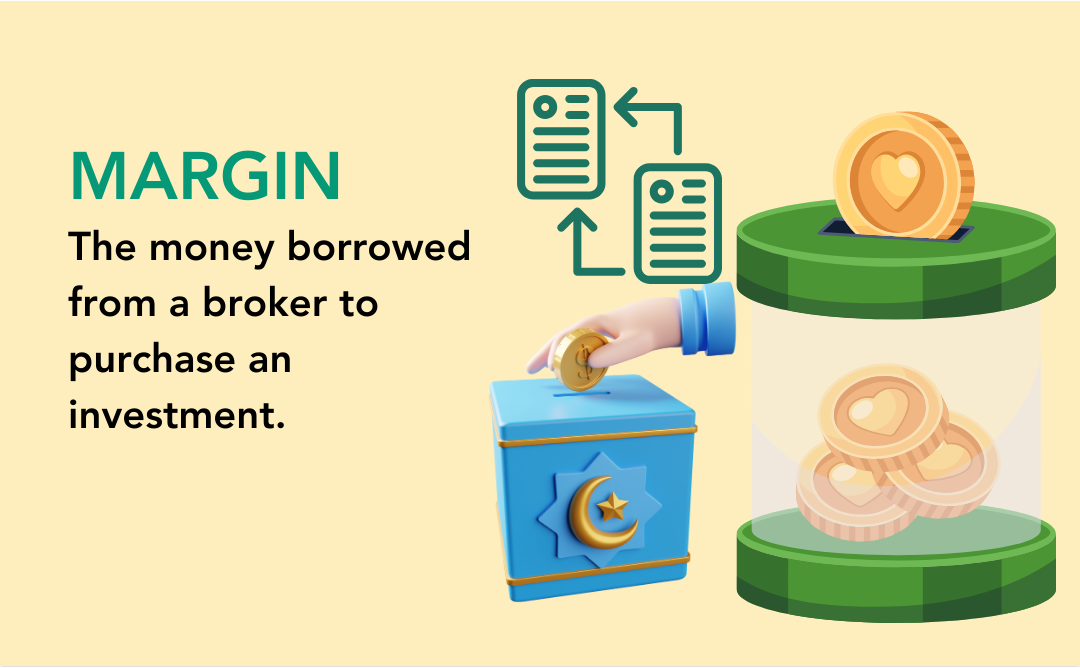Content
Introduction
Margin is the amount of equity that an investor has in their brokerage account. "To buy on margin" refers to buying securities with money borrowed from a broker. To do so, you need a margin account rather than a regular brokerage account. In a margin account, the broker lends the investor money to purchase more securities than they could have otherwise with their account balance.
This article explains margin money, the meaning of margin money, and its applications in the stock market and trading.

Unlock the full article - sign in with Gmail!
Expand Your Market Knowledge with 5paisa Articles
What is margin money?
An investor can borrow funds from a broker or an exchange to invest in securities. The investor must deposit a certain amount with the broker as a payment towards the risk undertaken by the lender. This deposit amount is known as Margin Money. The broker pays the rest of the asset’s value while the asset acts as collateral. This way an investor can use margin money in the stock market when he has insufficient funds.
Margin can be defined as the difference between the amount borrowed from the brokerage firm and the total value of the assets the investor holds in their investment account. Margins are payable in the following situations:
1. When stocks are bought on margin using borrowed money,
2. When you are taking intraday trading positions, selling long or short,
3. When you are trading futures,
4. When you sell options.
Understanding Margin and Margin Trading
Margin is the downpayment paid by the investor with the broker or the lender. It is usually deposited in a Margin account, exclusively meant for loans. This account is separate from the brokerage account. It is the account in which the brokerage firm lends money to buy securities.
Buying on margin
“Buying on margin” means buying securities by borrowing funds from a broker. It is a loan taken from the brokerage to buy securities. The brokerage lends the value of the security to the investor after they have paid the margin. An investor can buy more securities with their capital when they buy on margin. A margin account is required to buy on margin. It is different from a cash account which is used for regular trading.
Minimum Margin
The broker is required to obtain the consent of the investor to open a margin account. The margin account opening may follow the standard account opening procedures or have a separate procedure fulfilling specific requirements in the agreement. The minimum margin or maintenance margin is the amount of equity that an investor must maintain in their margin account after the purchase of the securities in order to hold the margin account.
Initial Margin
As per regulations laid out by the regulatory boards, the borrower or investor must deposit a minimum amount with the broker before the broker can lend funds. This is called the ‘initial margin’. For example, if your account's initial margin requirement is 50%, and the value of the security you wish to buy is Rs 10,000, then your margin will be Rs 5000.
Maintenance margin and margin call
Maintenance margin is the minimum fund that should be maintained in the margin account from which the losses of the account holder, if any, can be deducted. This is a requirement demanded by the broker to avoid losses. On failure of having the maintenance balance, the broker can force the borrower to sell their stock or securities to pay the debt.
A margin call is when the brokerage calls out the borrower to deposit funds into their account to bring the account to the stipulated maintenance levels. The brokerage has the power to close out or sell any open securities without the account holder’s permission if the margin call is not met. This step may invite commissions (paid by the borrower) for carrying out the transactions. They may also liquidate as many shares and contracts as required to exceed maintenance margins at unfavourable prices or losses.
Special considerations
Margin money is a type of borrowing and has a cost associated with it. The underlying securities become collateral and can be liquidated by the broker if the debt is not paid. Hence, investors use margin money to buy short-term investments or securities. The investors can pay the debt in short periods and avoid high interest on the loan. Long-term loans accumulate interest over time. As the total debt increases the odds of repaying the loan go against the borrower. The borrower's margin account is affected if the mandatory maintenance margin is not met.
All securities are not marginal or cannot be bought on margin. Brokerages do not allow margin trading for IPOs, mutual funds, and penny stocks. Further, every brokerage has restrictions on the stocks that can be margined. One needs to verify this detail with their broker.
Advantages and Disadvantages of Margin borrowing
An important aspect of margin borrowing are that the borrower can enjoy the returns without having to invest the total value of the security. This is called leverage. Also, as the security is making a profit its value keeps increasing. However, the broker or lender has all the necessary countermeasures in place in case of losses.
Some key advantages and disadvantages are presented below.
|
Advantages
|
Disadvantages
|
|
Leverage can earn greater gains
|
Leverage can result in greater losses.
|
|
It increases the flexibility of the borrower as they can buy more securities than they could have with their capital.
|
It can incur account fees, and high interest charges
|
|
It has more flexibility than other loans. There might not be an EMI to be paid regularly.
|
In the case of margin calls, the borrower may have to pay more to make up for losses.
|
|
There can be an ideal situation where the self-fulfilling cycle can increase collateral value and the borrower can enjoy more leverage.
|
In case of forced liquidation securities can be sold resulting in an overall loss.
|
Example of Margin
Let us say you deposit Rs 10,000 in your margin account. This means you can borrow Rs 20,000 from the account since you have deposited 50% of the purchase price. If you buy stock worth Rs 5000, you have Rs 15,000 of buying power remaining in your account. You have enough cash to cover the previous transaction without tapping into your margin. When you buy securities worth Rs 10,000. is when you start borrowing money.
The buying power of the margin is dependent on the value of the security. The values of securities keep changing daily; hence, the buying power will also keep changing daily.
Other uses of margin
The income statement of a business provides information to calculate various accounting margins. Margins are the differences between expenses and revenue. These margins reveal the health of the business in the immediate, medium-, and long-term periods.
Gross Margin is the difference between the Sales and the Cost of Goods. The Operating margin is calculated by subtracting the cost of goods and operating expenses from Sales. Profit margin is the difference between Sales and all expenses incurred. Profit margin is the most comprehensive information as it considers all the expenses and provides the real net profit margin the business earns. This is also the most closely watched margin by investors and stakeholders.
Margins in mortgage lending
Adjustable-rate mortgages offer a fixed rate of interest for a fixed time and then the rate may vary over time. The new rate is determined by adding a margin to an established index. For example, if the mortgage margin is 4% and the index rate is 5% then the interest rate on the mortgage will be 5+4 which is 9%. The index rate may change from time to time.
What are the risks of margin trading?
Margin trading involves buying securities by availing of a loan from the broker. As always, there is always a risk associated with securities. If the securities make losses, the investor will lose more money than what they had deposited as a margin with the broker. They may have to deposit more funds into the margin account or incur forced selling of securities to compensate for the loss in value of securities invested.
Bottom Line
Margin trading offers leverage to the investor to buy more securities than they can with their own funds. Investors can amplify their gains or losses in margin trading. By investing a margin of the total value of the security they can earn more gains than usual. However, if the sales of the security decline they stand to lose as many funds as they were to gain. The investor must have a sound strategy in place to make the most of this tool. They should use margin trading only for short-term investments and choose securities wisely.




